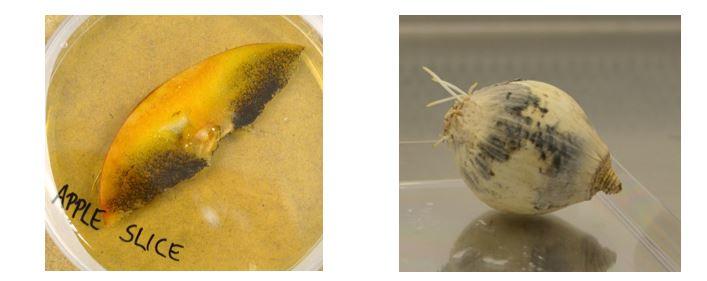Sustainable solutions to provide food safety

The Microbiology Society is undertaking a project entitled A Sustainable Future as part of our 75th Anniversary, which aims to highlight the Sustainable Development Goals (SDGs) to our members and empower them to use their research to evidence and impact the goals. Earlier this year, we put a call out to our members to submit case studies in the following three areas: antimicrobial resistance, soil health and the circular economy.
This case study is written by Franziska Wohlgemuth, a PhD student at the University of Nottingham, UK. It focuses on the circular economy; an alternative to a traditional linear economy (make, use, dispose), in which we keep resources in use for as long as possible, extract the maximum value from them while in use, then recover and regenerate products and materials at the end of each service life.
The problem: keeping food safe
Before you eat or cook fresh fruits and vegetables, the first thing you do is to wash them. Why? To remove dirt, potential pesticide residues and harmful micro-organisms from the surface. Of course, rinsing with water has only limited removal efficiency, which is why we expect food to be safe when we purchase it. For the food industry, this proposes two challenges:
- the chemical safety of food: making sure pesticide and sanitiser residues are absent or below the legal limits
- the biological safety: ensuring the absence of pathogenic micro-organisms and other micro-organisms which could cause spoilage during transport and storage, e.g. fungal micro-organisms such as mould
To tackle unwanted micro-organisms on food, washing steps with chemical sanitisers are often applied, e.g. after the harvest of fruits and vegetables. To ensure the chemical safety of the produce, there is ongoing research to develop better, cleaner sanitisers. Naturally, sanitisers are also used outside of the food industry, for instance in medical settings, and the importance of effective sanitisers has become more obvious than ever during the Covid-19 pandemic.

Figure 1: Growth of the fungal food spoilage organism Aspergillus niger on apple slices (left) and onions (right).
For the food industry, developing good sanitisers that prevent microbial food spoilage is incredibly important. At least 14% of global food production is lost during processing, transport and storage [1] while world hunger is an ongoing crisis, underlined by the 2020 Nobel Peace Prize for the World Food Programme.
Electrolysed water: a clean, accessible solution?
One sanitiser that has been gaining interest in the food industry is called electrolysed water. Its main advantage is that it can be produced anywhere in the world from simple ingredients. In an electrolysis unit (which runs on electricity), the electrolysed water is produced from water and table salt. So the sanitiser can be produced on demand and on site, and it is no longer necessary to buy, ship and store sanitiser.
During the electrolysis process, different active chemical species are formed that contribute to killing micro-organisms and sanitising food or water samples. However, many of these components are not very stable. This means that theoretically, the ‘active’ electrolysed water can slowly turn back into the ‘inactive’ water and salt mix, which can be reused, helping communities and industries build resilience against water scarcity.
Chemical residues: a dent in the circular economy
One problem faced by most chemical sanitisers, including electrolysed water, is their reactivity with other chemical substances. Imagine using electrolysed water to wash and sanitise freshly harvested onions: The electrolysed water can either react with micro-organisms on the onions (killing the micro-organisms and preventing spoilage), or with chemicals that are present (such as in soil associated with the onions, or water contaminants). The latter scenario inactivates the electrolysed water and prevents the killing of micro-organisms.
Fortunately, we could show that electrolysed water treatments are still effective against fungal micro-organisms even in the presence of relatively high levels of soil. On the other hand, the presence of proteins makes electrolysed water ineffective [2]. Understanding these reactivities is crucial especially when considering the application in parts of the world that lack access to clean water, where the electrolysed water may come in contact with a range of chemical water contaminants during their production and application.
When electrolysed water reacts with chemicals, not only does it no longer provide biological safety, it also affects the chemical safety of the produce. Harmful by-products can be formed when the main active compound free available chlorine reacts with organic compounds such as proteins.
Future perspectives: improved chemistries and intelligent use
Some research focuses on a chlorine free alternative, called ozonated water. It is also produced in an on-site electrolysis process and reduces the risk of by-product formation. However, ozonated water loses its efficacy against micro-organisms within minutes, whereas electrolysed water can be produced in batches and used over the course of a few days, with only some loss of efficacy. There may also be health risks associated with the formation of ozone gas during the production and use of ozonated water.
The choice of the right sanitiser depends on many factors such as the application (sanitising food or drinking water, versus sanitising factory surfaces) and the conditions (at home or in a factory, production in batch or immediately before use). Monitoring both the biological and chemical safety of produce and developing better and safer sanitisers are important for the future of food production. My PhD focuses on understanding the chemical reactivities of sanitisers such as electrolysed and ozonated water, and also the mechanisms by which they kill micro-organisms to help inform their use and further development.
References
[1] FAO (2019). The State of Food and Agriculture 2019. Moving Forward on Food Loss and Waste Reduction. Rome: FAO.
[2] Wohlgemuth, F., Gomes, R.L., Singleton, I., Rawson, F.J., Avery S.V. (2020). Top-down characterization of an antimicrobial sanitizer, leading from quenchers of efficacy to mode of action. Front. Microbiol. 11, 2397. doi.org/10.3389/fmicb.2020.575157

About the author
Franziska Wohlgemuth is a PhD student at the University of Nottingham, UK. More information about her work is available here.


